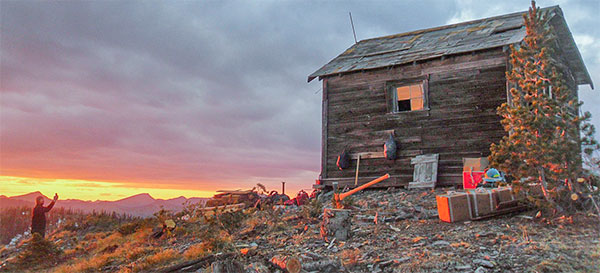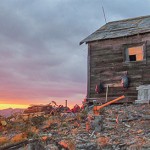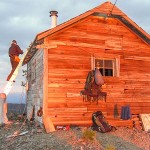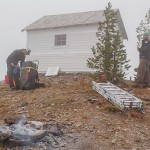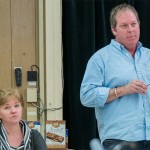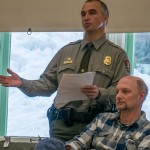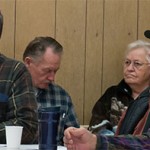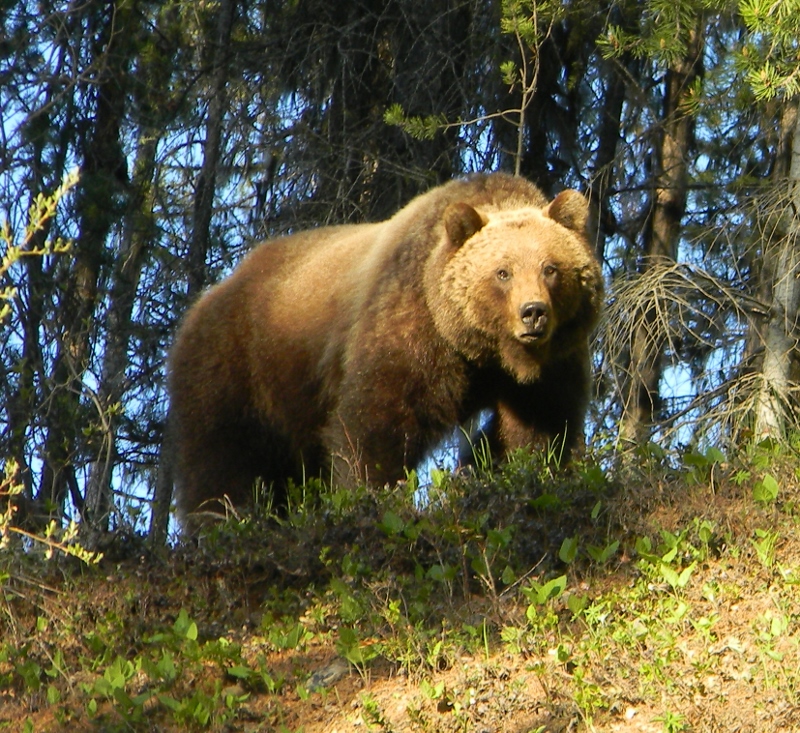 Here’s a message from Rick Mace, Research Biologist of the Montana Fish, Wildlife and Parks… The grizzly bear population monitoring team would like to capture and radio collar a couple grizzly bears in the NF Flathead River starting in the next few days. We would be working both on FS and private lands. All of the Forest Service sites would be off of the existing open road system as we have done in the past. All sites will have approved signs and we will obviously avoid any active timber sales and trail heads. Most of our sites have been used now for many years without incident. We anticipate capture sites in Trail, Red Meadow, and Moose Creeks. Also we may work off the main north fork road near Mud (Garnet) lake going towards the border. We would like run the capture program for a maximum of about 10 days depending on success, starting later this week. Approximately one month ago, we placed a press release in the local newspapers informing the public of our intent to capture bears on public lands.
Here’s a message from Rick Mace, Research Biologist of the Montana Fish, Wildlife and Parks… The grizzly bear population monitoring team would like to capture and radio collar a couple grizzly bears in the NF Flathead River starting in the next few days. We would be working both on FS and private lands. All of the Forest Service sites would be off of the existing open road system as we have done in the past. All sites will have approved signs and we will obviously avoid any active timber sales and trail heads. Most of our sites have been used now for many years without incident. We anticipate capture sites in Trail, Red Meadow, and Moose Creeks. Also we may work off the main north fork road near Mud (Garnet) lake going towards the border. We would like run the capture program for a maximum of about 10 days depending on success, starting later this week. Approximately one month ago, we placed a press release in the local newspapers informing the public of our intent to capture bears on public lands.
North Fork Neighbor Beth Weber Passed
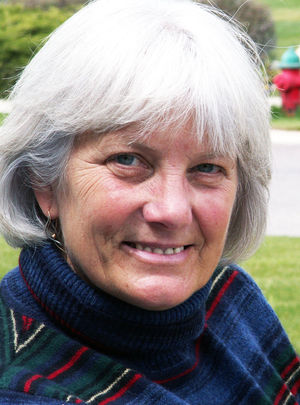 Our good neighbor Bethany Ann Warner Weber died from ovarian cancer on May 2, 2015. She is survived by her husband Steve Weber. Her obituary in the Daily Inter Lake says… Beth enjoyed her time with family and friends at the North Fork cabin and various North Fork community activities which included creative roles in the Polebridge Fourth of July parade, her many years hiking in Glacier National Park with her hiking groups, The Great Gripe Getaway and The Trampers, her rotating supper club, the Basic Food Group, her Riverview Greens book club, all things Notre Dame, and she was a proud member of PEO, Chapter BM. Summer trips with her nine grandchildren were planned carefully and were a great source of pleasure. Beth’s full obituary may be found here.
Our good neighbor Bethany Ann Warner Weber died from ovarian cancer on May 2, 2015. She is survived by her husband Steve Weber. Her obituary in the Daily Inter Lake says… Beth enjoyed her time with family and friends at the North Fork cabin and various North Fork community activities which included creative roles in the Polebridge Fourth of July parade, her many years hiking in Glacier National Park with her hiking groups, The Great Gripe Getaway and The Trampers, her rotating supper club, the Basic Food Group, her Riverview Greens book club, all things Notre Dame, and she was a proud member of PEO, Chapter BM. Summer trips with her nine grandchildren were planned carefully and were a great source of pleasure. Beth’s full obituary may be found here.
Beth is going to be missed by everyone on the North Fork. And we apologize to Steve for not having said something sooner. We failed to see her obituary in the paper until today. We’ll try to be more vigilant in the future.
Tom Edwards, Long Time North Forker, Passed
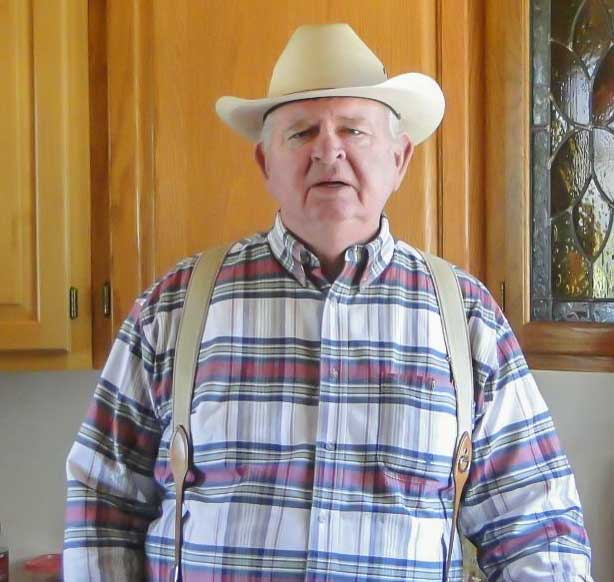 Tom Edwards, “North Forker” and long time resident of the Flathead valley passed away on May 15, 2015 at Whitefish North Valley Hospital, after a battle with lung cancer. Tom was born in 1944, in Seattle, the first of three sons born to Burt and Thelma Edwards. He spent the summers of his youth at the Logging Cr. Ranger Station where his father worked as a Park Ranger. These early interactions on the North Fork fueled his life long love for the local area.
Tom Edwards, “North Forker” and long time resident of the Flathead valley passed away on May 15, 2015 at Whitefish North Valley Hospital, after a battle with lung cancer. Tom was born in 1944, in Seattle, the first of three sons born to Burt and Thelma Edwards. He spent the summers of his youth at the Logging Cr. Ranger Station where his father worked as a Park Ranger. These early interactions on the North Fork fueled his life long love for the local area.
Tom’s gregarious nature made him a natural salesman. These skills served him well in his career as he moved from grocery store clerk to manager, and eventually into sales with Western Building Center, where he worked until his retirement in 2011.
Tom loved good food, and socializing, and enjoyed visiting and playing cards with friends. He took pride in his community. He was active with the Columbia Falls City Council and served on the Board for Whitefish North Valley Hospital as well as being actively engaged in the North Fork Landowner Association and History Project.
Twice married, Tom is survived by his wife Carmen Edwards as well as many loved ones, cherished friends and family members. Tom wished for a simple remembrance with no funeral services. Memorial gifts in Tom’s name can be made to the North Fork Landowner Association for continued maintenance of Sondreson’s Hall and other community events: P.O. Box 1603 Columbia Falls, MT 59912.
2015 NFLA Spring Newsletter is Here
The 2015 NFLA Spring Newsletter is completed and on its way. Folks who have paid their 2015 dues will receive their newsletter in the mail soon. Everyone is invited to check out this year’s newsletter as well as newsletters from years past on the NFLA Newsletter page.
This year’s newsletter includes a letter from NFLA President Karen McDonough, information about square dancing on the North Fork from Debo Powers, the 2015 Firewise Day and hazardous fuels grant from Molly Shepherd, and much more.
The mailed newsletter also includes a 2015 calendar. Calendar events can also be viewed on the Calendar page. This page will be updated throughout the year as new events are added or dates/times of current events change.
Don’t have internet to check for changes? Don’t worry, you can check the local NFLA Bulletin Boards. All new information and/or changes to the calendar will be posted. One of the boards is located between the Merc and the Northern Lights Saloon and the other is at the entrance to Home Ranch Bottoms Store. They will be kept updated. Don’t miss out, keep informed!
We want to say a special thanks to Allen Chrisman, Bonny Ogle, Carol Dolan-Groebe and all of the other NFLA members who worked so hard to get this newsletter written and distributed. We’re all in your debt.
It’s going to be a great summer!
Weed Resources to Download
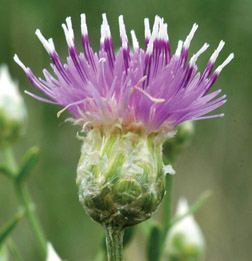 In March of 2015 Flathead National Forest, CHS, and others sponsored workshops focusing on weed identification, plant physiology, non-chemical control options, understanding chemical labels, calibrating equipment, weed law and safety. Richard Hildner and Suzanne Daniel attended and picked up some very helpful materials indeed. Check them out and download from the Weeds Committee page.
In March of 2015 Flathead National Forest, CHS, and others sponsored workshops focusing on weed identification, plant physiology, non-chemical control options, understanding chemical labels, calibrating equipment, weed law and safety. Richard Hildner and Suzanne Daniel attended and picked up some very helpful materials indeed. Check them out and download from the Weeds Committee page.
Update on the Coal Ridge Cabin
Andy Huntsberger, Assistant Fire Management Officer – Operations, Flathead National Forest sent in an update on work they have been doing at the Coal Ridge Cabin. Here is a timeline:
- 2012 we put a new roof on and installed a new wood stove and pipe
- 2014 installed all new siding (donated be the Northwest Montana Forest Fire Lookout Association), new coat of stain and all new glass
- 2015 we plan on finishing/second coat of stain and possibly replacing some floor boards
Andy goes on to say… When I was at the Cabin last summer I read the entries in the visitor log and it was all very positive and informative. The Cabin is currently being used as a day shelter for hikers and at this time we do not plan on changing this. We could and would post someone at this cabin, if needed, during a wildfire event. However, on a regular and reoccurring basis we plan on leaving it open to the public. It is 3.5 mile hike and a decent pull to the site, ideally this will deter any vandalism. We encourage the public to visit and enjoy this site.
Finally, Andy sent some photographs of the Coal Ridge Cabin, before and after work. Here they are:
North Fork History Project Takes a Leap Forward
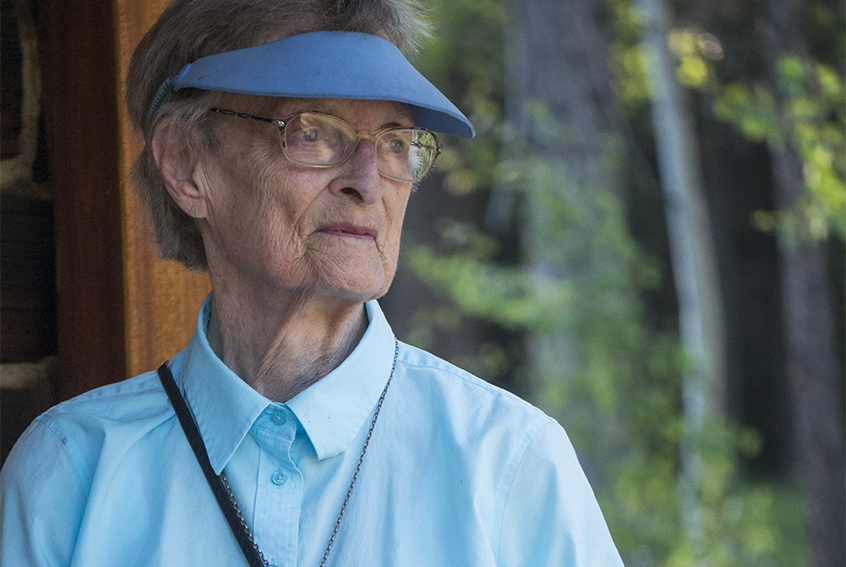 Several years ago, members of the NFLA History Committee began to interview and record the stories of people who have been in the North Fork for a long time. Folks talk about what the North Fork was like when they arrived, going to school on the North Fork, encounters with bears, moose, and bobcats and much more. At this point there are 17 recordings that can be downloaded from the NFLA website at nflandowners.org/north-fork-history-project/.
Several years ago, members of the NFLA History Committee began to interview and record the stories of people who have been in the North Fork for a long time. Folks talk about what the North Fork was like when they arrived, going to school on the North Fork, encounters with bears, moose, and bobcats and much more. At this point there are 17 recordings that can be downloaded from the NFLA website at nflandowners.org/north-fork-history-project/.
Recently, the history project took a major step forward when Chris Graff and Monica Phillips volunteered to pay for written transcripts from these interviews. They came up with this idea as a way to support the history project and make the interviews accessible to more people. Thanks to Chris and Monica for their generous donation! The interviews can now be read on the website.
To make the history page even more interesting, Patti Hart has added photographs of those who have been interviewed and those who have been featured in North Fork short stories.
So check out the new and improved North Fork History Project page.
Fire Mitigation Committee Report, Late Winter 2015
2015 Firewise Day
The North Fork has been recognized as a Firewise Community for ten years. One of the requirements for continuing recognition is holding an annual Firewise Day event. The North Fork’s annual Firewise workshops have been informative and well-attended, covering a range of wildfire and stewardship topics.
This year, the NFLA’s Fire Mitigation Committee will sponsor its Firewise workshop on Wednesday, July 15 2015 from 9:30 a.m. to noon, immediately preceding the Summer Interlocal meeting. Although plans for the event are not yet complete, the committee expects to show a video of fire behavior during the 2014 Pacific Northwest fire season. Tentatively, presenters will include Lincoln Chute, Flathead County Fire Service Area Manager, and committee co-chair Allen Chrisman. We’ll probably also hear updates from the agency representatives with whom we work. More information about the program will be posted on the NFLA website when the agenda is final.
Hazardous Fuels Grants
Since the fires of 2003, the Fire Mitigation Committee has helped numerous private landowners treat hazardous forest fuels on their properties by obtaining cost-share grants. The grants have paid 75% of the cost of an eligible project and the landowner has contributed the remaining 25%.
We are currently working on our fourth grant, this one in the amount of $91,000. One of our priorities for the grant is to reduce fuel accumulations along the lower stretch of Trail Creek Road, where it passes through private property. Treating fuels there will improve ingress and egress for landowners, allow safer access for firefighters, and afford an escape route over the Whitefish Divide. Committee members are contacting landowners to discuss the program and to determine their interest in participation.
Lincoln Chute has obtained approval from the Flathead County commissioners to use a county chipper to help dispose of slash generated along Trail Creek Road. We’ll need to show substantial, wide-spread benefit to warrant use of the equipment. Landowners also will need to cut slash material to size and align it along the roadside to facilitate handling.
More information about participation in the grant program is available from Bill Swope, who may be reached at 406-250-9812 or at bhswope@gmail.com.
North Fork Winter Interlocal Agreement 2015 Meeting Minutes
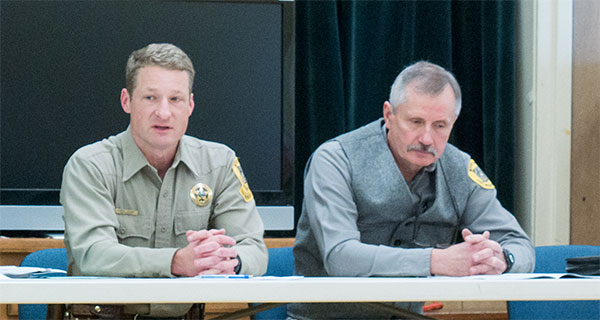 The winter North Fork Interlocal Agreement meeting took place last Wednesday, February 11th, at the Community Building in West Glacier. As in the past, this meeting was well attended by North Forkers and agency representatives alike. Allen Chrisman was kind enough to take extensive notes and turn them into minutes for the meeting. These include answers to specific questions submitted by North Forkers prior to the meeting. These are attached here as a pdf. The next Interlocal Agreement meeting will take place this coming summer. Keep an eye on the NFLA calendar for the date and details.
The winter North Fork Interlocal Agreement meeting took place last Wednesday, February 11th, at the Community Building in West Glacier. As in the past, this meeting was well attended by North Forkers and agency representatives alike. Allen Chrisman was kind enough to take extensive notes and turn them into minutes for the meeting. These include answers to specific questions submitted by North Forkers prior to the meeting. These are attached here as a pdf. The next Interlocal Agreement meeting will take place this coming summer. Keep an eye on the NFLA calendar for the date and details.
Ed “Mac” McNeil Passed
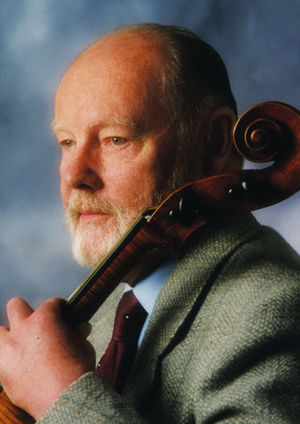 Last Sunday, February 8th, long time North Forker Ed “Mac” McNeil passed away. Mac and his wife Cecily bought land near Dutch Creek in Glacier National Park in the early 60s. They later bought 103 acres and built a cabin on the other side of the river near Moose Creek and lived there during the summers.
Last Sunday, February 8th, long time North Forker Ed “Mac” McNeil passed away. Mac and his wife Cecily bought land near Dutch Creek in Glacier National Park in the early 60s. They later bought 103 acres and built a cabin on the other side of the river near Moose Creek and lived there during the summers.
Mac and Cecily were early members of the North Fork Improvement Association which turned into the North Fork Landowners Association of today. They also worked to get a zoning petition and helped to found the North Fork Compact in 1973 in an effort to save the North Fork from development.
North Forkers have fond memories of events and square dances with Mac McNeil, Cecily, and their two sons Alan and Bruce. Mac will be missed.
If you are interested in hearing more about the North Fork from Mac and Cecily, there are audio interviews with them both on the North Fork History Project web page. You can get to that by clicking here.
There is also an excellent obituary provided by the Daily Inter Lake.
